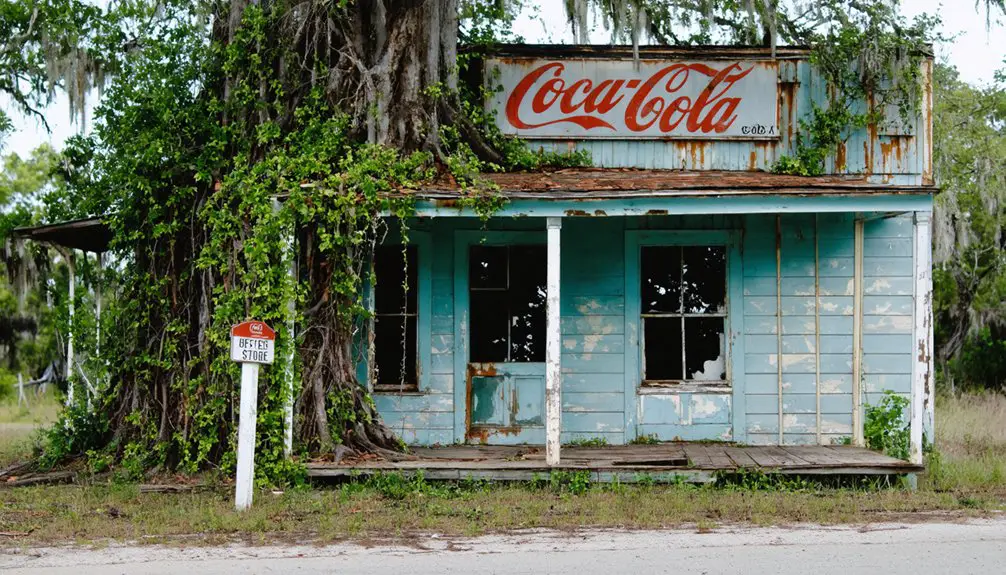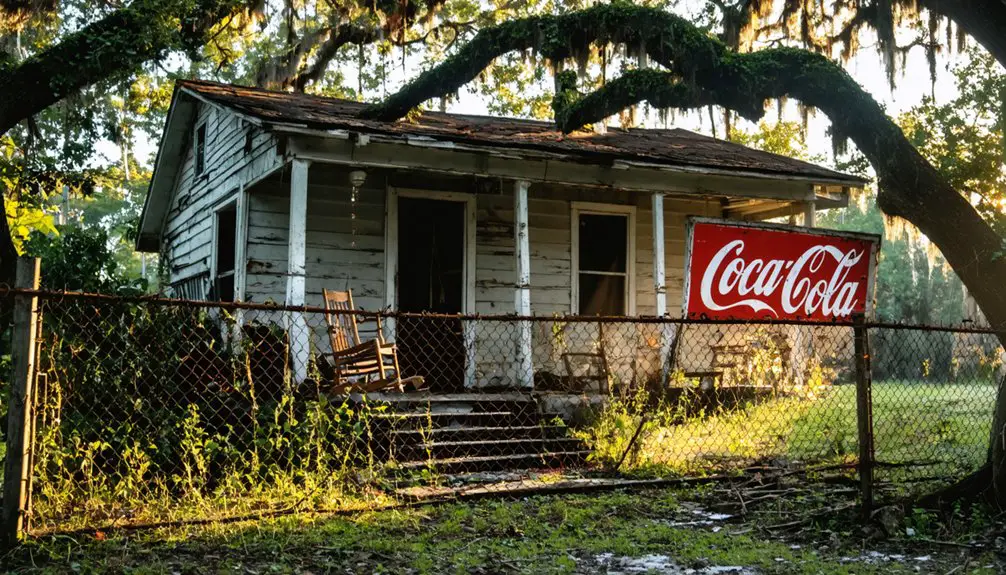You’ll find Lulu, Florida, as an inhabited ghost town in Columbia County, established in 1869 alongside the Georgia Southern Florida Railroad. The town flourished through cotton farming, with Theodore “Thee” Pearce’s influence evident in structures built in 1904. Today, you can explore remnants of late 1880s architecture, including an 1888 church with its distinctive bell tower and three wooden cabins. The town’s rich agricultural and railroad heritage holds countless stories within its historic landscape.
Key Takeaways
- Lulu is a partially inhabited ghost town in Columbia County, Florida, established in 1869 along the Georgia Southern Florida Railroad.
- The town retains a small residential population despite its ghost town status, with basic infrastructure still supporting current inhabitants.
- Historical landmarks include an 1888 church, three wooden cabins, and remnants of civic structures from its prosperous railroad era.
- The town’s economic decline followed the decreased importance of its railway depot, which once served logging and turpentine industries.
- Local residents informally preserve Lulu’s heritage, including historical structures and a nearby abandoned slave cemetery.
Origins and Founding Story
While many Florida ghost towns emerged organically, Lulu’s establishment was deliberately tied to the arrival of the Georgia Southern Florida Railroad. The settlement patterns centered around Robert Gillen, who arrived in 1869 and successfully persuaded the railroad company to build a station at what would become Lulu.
Unlike many spontaneous Florida settlements, Lulu was purposefully created around Robert Gillen’s railway station negotiations in 1869.
This strategic decision proved to be the primary founding influence that shaped the town’s development. Like many of Florida’s industrial towns, Lulu emerged as a hub of commercial activity during its early years.
You’ll find that Lulu’s early layout and infrastructure grew directly from its railroad-centric origins, with the station serving as the community’s focal point. The town attracted settlers seeking farming and trade opportunities, while railroad workers and their families formed the initial population base. Today, the area features a historic cemetery in Columbia County that draws visitors interested in exploring abandoned Florida sites.
Though the exact origin of the name “Lulu” remains unclear, the town’s deliberate establishment along the rail line defined its early character.
Historical Landmarks and Architecture
Although time has eroded much of Lulu’s architectural preservation, several notable structures from the late 1880s still stand as evidence to this former railroad town’s history.
Similar to ghost town ruins found in Rocky Mountain National Park, many of Lulu’s original structures have been lost to time.
You’ll find an 1888 church building with its distinctive bell tower, representing one of the town’s earliest and most significant landmarks.
Three partially standing wooden cabins showcase the typical late 19th-century construction methods, primarily using durable woods like bald cypress.
The town’s community significance is reflected in its civic structures, including remnants of the old city hall and various commercial buildings.
You’ll notice utilitarian structures like fruit stands and hangar-style buildings with weathered scales, indicating Lulu’s once-thriving business district.
While most buildings have succumbed to nature’s elements, these remaining structures offer glimpses into the daily life of this historic Florida settlement.
A former gas station with two pumps and an old payphone stands as a testament to the town’s more recent past.
Economic Rise and Development
During the early 20th century, Lulu emerged as a thriving agricultural settlement centered around cotton farming. Following the pattern of many Florida communities experiencing boom-bust cycles, the town’s economy fluctuated with market demands.
You’ll find Theodore “Thee” Pearce’s influence evident in the structures he built in 1904, marking the town’s early economic resilience. The transformation from dense palmetto and pine wilderness to productive farmland demonstrated the settlers’ determination to establish agricultural innovations. The community’s commercial district included two cotton gins that processed the area’s primary crop.
You can trace Lulu’s prosperity to its strategic railroad connections, which enabled efficient export of cotton and other crops to broader markets.
The town’s economic backbone relied on labor-intensive farming, with success depending heavily on seasonal cycles and market prices. Local businesses flourished by supporting the agricultural economy through equipment supplies and transport services, though eventually, competition from larger centers and shifting transportation routes would challenge Lulu’s market position.
Social Life and Community Legacy
Since its establishment in 1904, Lulu’s social life centered around Theodore “Thee” Pearce’s dance hall, which served as the heart of community gatherings and celebrations.
You’d find residents coming together regularly for dances, meetings, and social events that strengthened the bonds between farming families.
Cotton cultivation played a dual role in maintaining social cohesion, as harvests brought neighbors together in shared labor and celebration.
Like many of Florida’s ghost town remnants, physical traces of these cherished gathering places can still be found through scattered bricks and artifacts.
Railway Connection and Transportation Hub
You’ll find Lulu’s economic prosperity directly tied to its railroad depot, which served as the primary transportation hub for timber exports and agricultural shipments during the late 1800s.
The depot’s layout featured dedicated loading zones for both passenger service and freight operations, with timber being the dominant cargo handled at the facility.
Rail schedules through Lulu connected the town to major markets along the Georgia Southern Florida Railroad line, operating multiple daily freight and passenger services until the early 20th century decline.
Railroad’s Economic Impact
The Florida Railroad revolutionized transportation and commerce across the state by establishing the first steam-powered rail line connecting Fernandina on the east coast to Cedar Key on the west coast.
This railroad expansion cut shipping routes by 800 miles, bypassing the treacherous Straits of Florida and sparking economic transformation throughout the region.
You’ll find evidence of this growth in towns like Lulu, where the railroad created crucial trade connections for agricultural and industrial commerce.
The rail system enabled farmers and producers to ship oranges, timber, and other goods to national markets more efficiently than ever before.
Supporting industries flourished, including packing houses and warehouses, while the reliable transportation network attracted new labor and businesses.
Despite later challenges from competing transportation systems and economic downturns, the railroad’s impact fundamentally shaped Lulu’s development.
The railroad’s construction began in Fernandina in 1855, marking the start of Florida’s rail transportation era.
The Industrial Revolution’s influence on Florida’s development was particularly evident as railroads transformed previously undeveloped regions into thriving economic centers.
Depot Layout Features
Railroad infrastructure at Lulu’s depot showcased a well-planned transportation hub designed for both passenger and freight operations.
The depot’s spatial organization featured distinct zones for rail siding, cargo staging, and passenger waiting areas, all strategically positioned along the main track.
You’ll find evidence of the depot’s sophisticated layout in the remnants of graded roads that intersected the railroad, optimizing transport flow between rail and wagon traffic.
The cargo handling facilities included storage areas and loading zones, marked today by large cleared spaces and scattered structural debris.
Metal hardware and springs suggest maintenance areas for rolling stock, while brick foundations and coal fragments indicate the presence of permanent structures.
The depot’s design efficiently connected Lulu to Florida’s broader transportation network, serving as an essential link for the community’s economic activities.
Historical artifacts like Hery cup fragments discovered along the railroad line provide evidence of the depot’s role in supporting the local turpentine industry.
Train Schedule History
Since its establishment in 1869, Lulu’s railway connections evolved through the Georgia Southern Florida Railroad’s expansion, creating an essential transportation hub for both passengers and freight.
Train frequency aligned with the area’s industrial demands, particularly the logging and turpentine production cycles that drove the local economy. You’d find daily and weekly services connecting Lulu to larger market hubs, while scheduling changes reflected the ebb and flow of industrial activities at nearby sawmills and turpentine operations.
The Atlantic Coast Line Railroad‘s presence further shaped the town’s rail services, though exact timetables from this era remain elusive.
As transportation modes shifted in the mid-20th century, Lulu’s train schedules gradually diminished, marking the beginning of the town’s decline toward its eventual ghost town status.
Present-Day Status and Heritage

Located in Columbia County, Florida, Lulu exists today as an inhabited ghost town, maintaining a small residential presence despite its diminished status from its historic peak.
While the current population remains undocumented in official census data, you’ll find sparse residential development and basic local infrastructure supporting the remaining inhabitants.
The area holds significant historical value, particularly due to its nearby abandoned slave cemetery, which stands as a monument to the region’s African American heritage.
You’re unlikely to find detailed signage or tourist information, as preservation efforts remain minimal and locations of sensitive sites are intentionally kept discreet.
The ghost town’s cultural landscape presents a unique blend of active residency and historical preservation concerns, with local residents serving as informal custodians of Lulu’s enduring heritage.
Frequently Asked Questions
What Was the Population of Lulu During Its Peak Years?
You won’t find documented peak population records for Lulu, but town demographics suggest it likely housed only several hundred residents at most during its railroad-linked heyday in the late 1800s.
Are There Any Surviving Photographs of the Original Dance Hall?
You won’t find any confirmed surviving photographs of the original dance hall in public archives. Historical documentation of Lulu’s social venues remains sparse, though local historical societies might hold undiscovered images.
What Happened to Theodore Pearce’s Family After Founding Lulu?
You’ll find the Pearce legacy continued through multiple generations, with descendants staying in Columbia County. Theodore’s family expanded considerably, though later family struggles led to dispersal across Florida’s communities.
Did Any Notable Events or Disasters Contribute to Lulu’s Decline?
Slowly but surely, you’ll find no dramatic disasters marked Lulu’s decline. Instead, it dwindled through typical economic downturns, while the 1894-1895 Big Freeze’s agricultural devastation affected the broader region’s prosperity.
Can Visitors Access the Remaining Historical Structures in Lulu Today?
You’ll need a permit from the Stiltsville Trust to access Lulu’s historical structures. This visitor access system balances your freedom to explore with necessary historical preservation and safety measures.
References
- https://abc3340.com/news/local/sister-of-shark-attack-survivor-recalls-the-horror-the-entire-ocean-was-red
- https://www.youtube.com/watch?v=kXGAKmjGMXg
- https://en.wikipedia.org/wiki/List_of_ghost_towns_in_Florida
- https://www.tiktok.com/@beyondflorida/video/7263519112121355562
- https://www.ghosttowns.com/states/fl/lulu.html
- http://www.shrimpnfishflorida.com/forums/threads/lake-county-fl-ghost-towns.5641/
- https://www.101travelbits.com/single-post/2018/08/01/three-ghost-towns-of-rocky-mountain-national-park
- https://www.denver7.com/news/local-news/clothes-left-hanging-in-the-closet-the-story-behind-lulu-city-a-ghost-town-in-rocky-mountain-national-park
- https://www.youtube.com/watch?v=bNjqcQ5SMwg
- https://www.youtube.com/watch?v=189BC3-noOM



